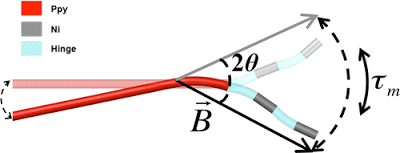Scientists are reporting in the ACS journal Nano Letters the development of new nanobots that can move easily through body fluids to their targets.
The researchers strung together three links in a chain about as long as a silk fiber is wide. One segment was a polymer, and two were magnetic, metallic nanowires. They put the tiny devices in a fluid even thicker than blood. And when they applied an oscillating magnetic field, the nanoswimmer moved in an S-like, undulatory motion at the speed of nearly one body length per second. The magnetic field also can direct the swimmers to reach targets.
Abstract
Micro- and nanorobots operating in low Reynolds number fluid environments require specialized swimming strategies for efficient locomotion. Prior research has focused on designs mimicking the rotary corkscrew motion of bacterial flagella or the planar beating motion of eukaryotic flagella. These biologically inspired designs are typically of uniform construction along their flagellar axis. This work demonstrates for the first time planar undulations of composite multilink nanowire-based chains (diameter 200 nm) induced by a planar-oscillating magnetic field. Those chains comprise an elastic eukaryote-like polypyrrole tail and rigid magnetic nickel links connected by flexible polymer bilayer hinges. The multilink design exhibits a high swimming efficiency. Furthermore, the manufacturing process enables tuning the geometrical and material properties to specific application
NanoLetters – Undulatory Locomotion of Magnetic Multilink Nanoswimmers
7 pages of supplemental information
SOURCES – ACS, Nanoletters

Brian Wang is a Futurist Thought Leader and a popular Science blogger with 1 million readers per month. His blog Nextbigfuture.com is ranked #1 Science News Blog. It covers many disruptive technology and trends including Space, Robotics, Artificial Intelligence, Medicine, Anti-aging Biotechnology, and Nanotechnology.
Known for identifying cutting edge technologies, he is currently a Co-Founder of a startup and fundraiser for high potential early-stage companies. He is the Head of Research for Allocations for deep technology investments and an Angel Investor at Space Angels.
A frequent speaker at corporations, he has been a TEDx speaker, a Singularity University speaker and guest at numerous interviews for radio and podcasts. He is open to public speaking and advising engagements.


